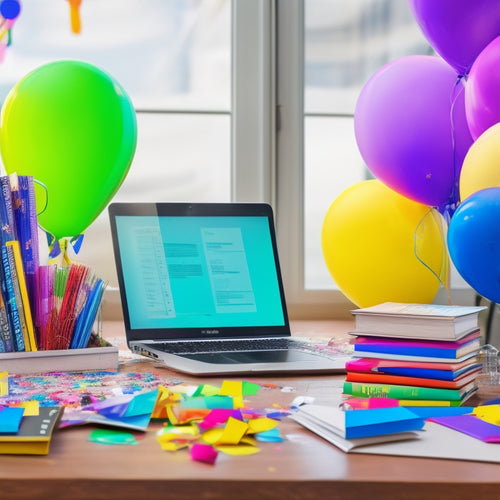
Balancing Act: Teacher's Guide to Classroom Success
Share
To achieve classroom success, teachers must master the delicate balancing act of managing time, prioritizing self-care, building resilience, reducing stress, and achieving work-life harmony. By implementing effective time management strategies, prioritizing self-care, and creating a supportive classroom environment, teachers can reduce overwhelm and increase job satisfaction. Additionally, incorporating stress reduction techniques and setting clear boundaries between work and personal life are essential for sustained success. By adopting these essential strategies, teachers can optimize their performance and create a positive teaching experience. As you navigate the complexities of teaching, discover how these principles can be tailored to your unique needs.
Key Takeaways
• Implement time-saving techniques like batching tasks and prioritize self-care to maintain energy levels and reduce overwhelm.
• Create a supportive classroom environment through relationships, individualized support, and open communication to foster student engagement.
• Incorporate mindfulness practices, deep breathing exercises, and short breaks to reduce stress and anxiety and improve overall well-being.
• Establish clear boundaries between work and personal life, prioritize self-care activities, and learn to say 'no' to non-essential tasks.
• Optimize daily schedules, prioritize tasks based on importance, and use productivity tools to manage workload effectively and achieve work-life harmony.
Mastering Time Management Strategies
How can teachers effectively allocate their time to accommodate the multitude of tasks and responsibilities that come with being an educator, while also maintaining a sense of balance and control in their busy classrooms?
By incorporating time-saving techniques, such as batching similar tasks and utilizing productivity tools, teachers can optimize their daily schedules.
Effective stress management strategies, including prioritization and delegation, can also help reduce feelings of overwhelm.
Furthermore, self-care strategies, such as taking regular breaks and engaging in relaxation techniques, can help build resilience and improve overall well-being.
Prioritizing Self-Care for Success
As educators, it is essential to recognize that prioritizing self-care is not a luxury, but a necessity for maintaining the physical, emotional, and mental energy required to teach effectively and sustain a successful classroom environment.
By incorporating self-reflection practices and mindfulness exercises into our daily routine, we can better manage stress and maintain a sense of calm. Establishing wellness routines, such as regular exercise and healthy eating, also plays a crucial role in sustaining our energy levels.
Additionally, setting professional boundaries is crucial in preventing burnout and maintaining a healthy work-life balance. By prioritizing self-care, educators can optimize their performance, increase job satisfaction, and create a more positive and productive learning environment for their students.
Building Resilience in the Classroom
By prioritizing self-care, educators set themselves up for success, but they must also cultivate resilience in their students to create a thriving classroom environment that can weather the inevitable challenges that arise. Building resilience in students involves more than just teaching coping mechanisms; it requires creating an environment that fosters growth, support, and connection.
-
Building relationships with students through regular check-ins and individualized support helps to create a sense of belonging and reduces feelings of isolation.
-
Enhancing engagement through hands-on activities and real-world applications increases motivation and encourages students to take ownership of their learning.
-
Encouraging open communication and active listening helps to build trust and promotes a growth mindset.
-
Providing opportunities for student reflection and self-assessment helps to develop metacognitive skills and increases self-awareness.
-
Celebrating small victories and acknowledging effort, not just achievement, helps to build confidence and promotes a growth mindset.
Effective Stress Reduction Techniques
Effective stress reduction techniques are essential for educators to manage their workload and maintain a healthy work-life balance, as excessive stress can negatively impact both their personal well-being and teaching performance.
To mitigate this, educators can incorporate mindfulness practices into their daily routine. This can be as simple as taking a few minutes each morning to focus on deep breathing exercises, allowing the mind to quiet and center.
Additionally, incorporating short breaks throughout the day to practice mindfulness can help reduce feelings of overwhelm and anxiety. By prioritizing stress reduction, educators can improve their overall well-being, leading to increased job satisfaction and a more positive teaching experience.
Achieving Work-Life Harmony
One of the most significant challenges educators face is striking a balance between their professional and personal lives, which is crucial for maintaining their overall well-being and delivering their best in the classroom.
Achieving work-life harmony is important to guarantee teachers can manage their responsibilities effectively and avoid burnout. Here are some strategies to help educators achieve a better work-life balance:
-
Set clear boundaries between work and personal life
-
Prioritize self-care activities, such as exercise and meditation
-
Learn to say 'no' to non-essential tasks and commitments
-
Use technology wisely to manage workload and reduce stress
-
Schedule regular breaks and vacations to recharge
Frequently Asked Questions
How Can I Maintain Student Engagement During Lesson Transitions?
According to a Gallup study, 55% of students report feeling disengaged during lesson handoffs. To combat this, implement smooth handoffs by providing clear instructions and visual reminders, ensuring a seamless flow and minimizing disruptions, thereby maintaining student engagement.
What Are Some Strategies for Minimizing Paperwork and Grading Time?
To minimize paperwork and grading time, implement a paperless workflow by digitizing assignments and utilizing online grading tools, and adopt efficient scoring methods, such as rubrics and self-assessment, to streamline the evaluation process.
Can I Use This Guide if I'm a Non-Traditional or Special Education Teacher?
"Did you know that 70% of special education teachers report feeling overwhelmed? This guide's adaptation strategies and inclusive mindset can be tailored to non-traditional and special education settings, empowering teachers to achieve a better work-life balance and focus on student success."
How Do I Communicate My Needs to My School Administration Effectively?
To effectively communicate your needs to school administration, prioritize building relationships, identify Admin Priorities, and articulate how your requests support Teacher Empowerment, ultimately enhancing student outcomes and aligning with administrative goals.
Are There Digital Resources Available to Supplement This Guide's Strategies?
"When it comes to supplementation, the digital world is a treasure trove. Digital tools and online platforms can be a game-changer, offering a wealth of resources to support teaching strategies and enhance classroom success."
Related Posts
-

Boost Your Grades With Proper Citations
Proper citation is an important aspect of academic writing that can greatly impact the credibility and validity of re...
-

Revamp Your Home With Spring Cleaning Checklist
Spring's arrival presents a prime opportunity to transform your living space, shedding the remnants of winter's hiber...
-

Revamp Your Home This Spring
You're ready to trade in clutter and chaos for a fresh, revitalized space that sparks joy and energizes your daily ro...


